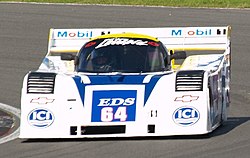 | |||||||||
| Category | IMSA GTP | ||||||||
|---|---|---|---|---|---|---|---|---|---|
| Constructor | Pratt & Miller | ||||||||
| Designer(s) | Bob and Bill Riley | ||||||||
| Technical specifications[2] | |||||||||
| Chassis | Carbon fibre and aluminum honeycomb composite monocoque with steel roll cage | ||||||||
| Suspension (front) | Double wishbone with pushrod-actuated inboard spring/damper | ||||||||
| Suspension (rear) | Double wishbone with pushrod-actuated bellhousing-mounted spring/damper | ||||||||
| Length | 189 in (480.1 cm) | ||||||||
| Width | 78 in (198.1 cm) | ||||||||
| Height | 41 in (104.1 cm) | ||||||||
| Wheelbase | 110 in (279.4 cm) | ||||||||
| Engine | Katech-built Chevrolet 6.5–7.2 L (397–439 cu in) V8 Naturally aspirated mid-mounted | ||||||||
| Transmission | Hewland 5-speed + reverse manual | ||||||||
| Weight | 1,800 lb (816 kg) | ||||||||
| Tyres | Goodyear Eagle BBS wheels, 17x13 front, 17x15 rear | ||||||||
| Competition history | |||||||||
| Notable entrants | MTI Racing Prototype Technology Group Wayne Taylor Racing | ||||||||
| Notable drivers | |||||||||
| Debut | 1991 Toyota Camel Grand Prix of Palm Beach | ||||||||
| |||||||||
| Teams' Championships | 0 | ||||||||
| Constructors' Championships | 0 | ||||||||
| Drivers' Championships | 0 | ||||||||
The Intrepid RM-1 (also known as the Intrepid GTP or Chevrolet Intrepid) is a sports prototype racing car designed in 1991 by Bob and Bill Riley and built by Pratt & Miller to IMSA GTP specifications.[2] Powered by a Chevrolet V8 engine, it was campaigned variously by Jim Miller, Prototype Technology Group and Wayne Taylor in the IMSA Camel GT from 1991 through 1993. Though it won only one race in its three seasons of competition, the shovel-nosed Intrepid was notable for the extreme—and at one point, disastrous—levels of downforce it generated, giving it the highest cornering speeds of any prototype of its era. The car's development was set back by a devastating 1991 crash at Watkins Glen that critically injured driver Tommy Kendall, and the program never fully recovered.[2]
- ^ "1991 Intrepid RM-1 Chevrolet - Images, Specifications and Information". Ultimatecarpage.com.
- ^ a b c Martin, J.A. & Fuller, M.J. (2008). Inside IMSA's Legendary GTP Race Cars: The Prototype Experience. Motorbooks. pp. 221–231.
